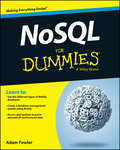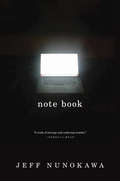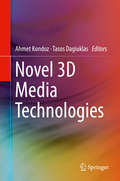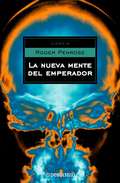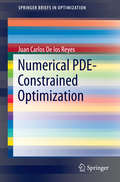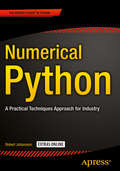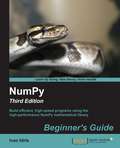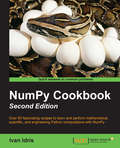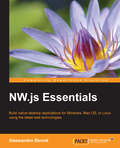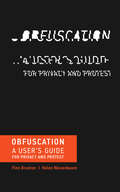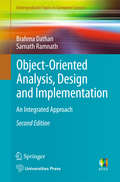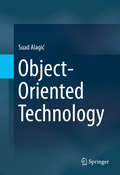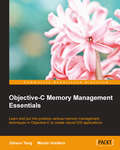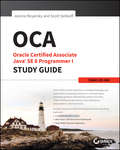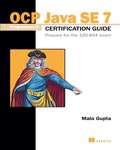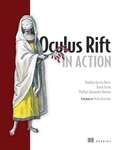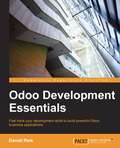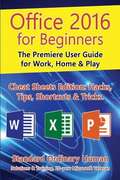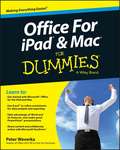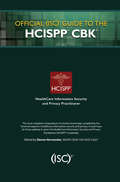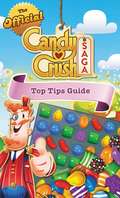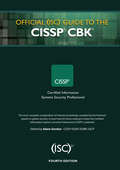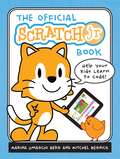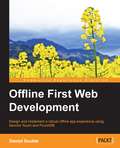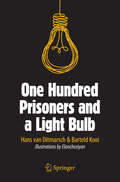- Table View
- List View
NoSQL For Dummies
by Adam FowlerGet up to speed on the nuances of NoSQL databases and what they mean for your organizationThis easy to read guide to NoSQL databases provides the type of no-nonsense overview and analysis that you need to learn, including what NoSQL is and which database is right for you. Featuring specific evaluation criteria for NoSQL databases, along with a look into the pros and cons of the most popular options, NoSQL For Dummies provides the fastest and easiest way to dive into the details of this incredible technology. You'll gain an understanding of how to use NoSQL databases for mission-critical enterprise architectures and projects, and real-world examples reinforce the primary points to create an action-oriented resource for IT pros.If you're planning a big data project or platform, you probably already know you need to select a NoSQL database to complete your architecture. But with options flooding the market and updates and add-ons coming at a rapid pace, determining what you require now, and in the future, can be a tall task. This is where NoSQL For Dummies comes in!Learn the basic tenets of NoSQL databases and why they have come to the forefront as data has outpaced the capabilities of relational databasesDiscover major players among NoSQL databases, including Cassandra, MongoDB, MarkLogic, Neo4J, and othersGet an in-depth look at the benefits and disadvantages of the wide variety of NoSQL database optionsExplore the needs of your organization as they relate to the capabilities of specific NoSQL databasesBig data and Hadoop get all the attention, but when it comes down to it, NoSQL databases are the engines that power many big data analytics initiatives. With NoSQL For Dummies, you'll go beyond relational databases to ramp up your enterprise's data architecture in no time.
Note Book
by Jeff Nunokawa"The hunger for a feeling of connection that informs most everything I've written flows from a common break in a common heart, one I share with everyone I've ever really known."--Note BookEvery single morning since early 2007, Princeton English professor Jeff Nunokawa has posted a brief essay in the Notes section of his Facebook page. Often just a few sentences but never more than a few paragraphs, these compelling literary and personal meditations have raised the Facebook post to an art form, gained thousands of loyal readers, and been featured in the New Yorker. In Note Book, Nunokawa has selected some 250 of the most powerful and memorable of these essays, many accompanied by the snapshots originally posted alongside them. The result is a new kind of literary work for the age of digital and social media, one that reimagines the essay's efforts, at least since Montaigne, to understand our common condition by trying to understand ourselves.Ranging widely, the essays often begin with a quotation from one of Nunokawa's favorite writers--George Eliot, Henry James, Gerard Manley Hopkins, W. H. Auden, Robert Frost, or James Merrill, to name a few. At other times, Nunokawa is just as likely to be discussing Joni Mitchell or Spanish soccer striker Fernando Torres.Confessional and moving, enlightening and entertaining, Note Book is ultimately a profound reflection on loss and loneliness--and on the compensations that might be found through writing, literature, and connecting to others through social media.
Novel 3D Media Technologies
by Ahmet Kondoz Tasos DagiuklasThis book describes recent innovations in 3D media and technologies, with coverage of 3D media capturing, processing, encoding, and adaptation, networking aspects for 3D Media, and quality of user experience (QoE). The contributions are based on the results of the FP7 European Project ROMEO, which focuses on new methods for the compression and delivery of 3D multi-view video and spatial audio, as well as the optimization of networking and compression jointly across the future Internet. The delivery of 3D media to individual users remains a highly challenging problem due to the large amount of data involved, diverse network characteristics and user terminal requirements, as well as the user's context such as their preferences and location. As the number of visual views increases, current systems will struggle to meet the demanding requirements in terms of delivery of consistent video quality to fixed and mobile users. ROMEO will present hybrid networking solutions that combine the DVB-T2 and DVB-NGH broadcast access network technologies together with a QoE aware Peer-to-Peer (P2P) distribution system that operates over wired and wireless links. Live streaming 3D media needs to be received by collaborating users at the same time or with imperceptible delay to enable them to watch together while exchanging comments as if they were all in the same location. This book is the second of a series of three annual volumes devoted to the latest results of the FP7 European Project ROMEO. The present volume provides state-of-the-art information on immersive media, 3D multi-view video, spatial audio, cloud-based media, networking protocols for 3D media, P2P 3D media streaming, and 3D Media delivery across heterogeneous wireless networks among other topics. Graduate students and professionals in electrical engineering and computer science with an interest in 3D Future Internet Media will find this volume to be essential reading. Describes the latest innovations in 3D technologies and Future Internet Media Focuses on research to facilitate application scenarios such as social TV and high-quality, real-time collaboration Discusses QoE for 3D Represents the last of a series of three volumes devoted to contributions from FP7 projects in the area of 3D and networked media
La nueva mente del emperador: En Torno A La Cibernética, La Mente Y Las Leyes De La Física (Ciencia Y Tecnología Ser.)
by Roger PenroseUn apasionante paseo por la matemática y la física, y por los hallazgos del pensamiento humano. Durante décadas, los defensores de la inteligencia artificial han mantenido que los ordenadores harán pronto todo lo que la mente humana puede hacer. En su favor, se puede utilizar, por ejemplo, el que ya hay máquinas que juegan al ajedrez como los grandes maestros. Ahora bien, ¿comprenden el juego como lo hacemos nosotros? En este libro, Roger Penrose, probablemente el especialista en la teoría general de la relatividad más prestigioso del mundo y una de las mentes analíticas más originales de la actualidad, sostiene que existen facetas del pensamiento humano que nunca serán emuladas por un ordenador. Para defender esa tesis, Penrose recurre a una amplia gama de conocimientos científicos, que van desde la máquina de Turing hasta la estructura del cerebro, pasando por el teorema de Gödel, los agujeros negros y los blancos, la radiación de Hawking, la entropía o la mecánica cuántica. Entre los numerosos estudios existentes dedicados a la relación entre la mente y el cuerpo, esta ambiciosa obra sobresale tanto por su lucidez y claridad como por su rigor y profundidad. Reseña:«Un libro audaz, brillante e innovador. Cuando Penrose habla, los científicos escuchan.»The New York Times Book Review
Numerical PDE-Constrained Optimization
by Juan Carlos De los ReyesThis book introduces, in an accessible way, the basic elements of Numerical PDE-Constrained Optimization, from the derivation of optimality conditions to the design of solution algorithms. Numerical optimization methods in function-spaces and their application to PDE-constrained problems are carefully presented. The developed results are illustrated with several examples, including linear and nonlinear ones. In addition, MATLAB codes, for representative problems, are included. Furthermore, recent results in the emerging field of nonsmooth numerical PDE constrained optimization are also covered. The book provides an overview on the derivation of optimality conditions and on some solution algorithms for problems involving bound constraints, state-constraints, sparse cost functionals and variational inequality constraints.
Numerical Python: A Practical Techniques Approach for Industry
by Robert JohanssonNumerical Python by Robert Johansson shows you how to leverage the numerical and mathematical modules in Python and its Standard Library as well as popular open source numerical Python packages like NumPy, FiPy, matplotlib and more to numerically compute solutions and mathematically model applications in a number of areas like big data, cloud computing, financial engineering, business management and more. After reading and using this book, you'll get some takeaway case study examples of applications that can be found in areas like business management, big data/cloud computing, financial engineering (i. e. , options trading investment alternatives), and even games. Up until very recently, Python was mostly regarded as just a web scripting language. Well, computational scientists and engineers have recently discovered the flexibility and power of Python to do more. Big data analytics and cloud computing programmers are seeing Python's immense use. Financial engineers are also now employing Python in their work. Python seems to be evolving as a language that can even rival C++, Fortran, and Pascal/Delphi for numerical and mathematical computations.
NumPy: Beginner's Guide - Third Edition
by Ivan IdrisThis book is for the scientists, engineers, programmers, or analysts looking for a high-quality, open source mathematical library. Knowledge of Python is assumed. Also, some affinity, or at least interest, in mathematics and statistics is required. However, I have provided brief explanations and pointers to learning resources.
NumPy Cookbook - Second Edition
by Ivan IdrisIf you are a Python developer with some experience of working on scientific, mathematical, and statistical applications and want to gain an expert understanding of NumPy programming in relation to science, math, and finance using practical recipes, then this book is for you.
NW.js Essentials
by Alessandro BenoitIf you are an experienced Node.js developer who wants to create amazing desktop applications using NW.js, this is the book for you. Prior knowledge of HTML5, jQuery, and CSS is assumed.
Obfuscation: A User's Guide for Privacy and Protest (The\mit Press Ser.)
by Helen Nissenbaum Finn BruntonHow we can evade, protest, and sabotage today's pervasive digital surveillance by deploying more data, not less—and why we should.With Obfuscation, Finn Brunton and Helen Nissenbaum mean to start a revolution. They are calling us not to the barricades but to our computers, offering us ways to fight today's pervasive digital surveillance—the collection of our data by governments, corporations, advertisers, and hackers. To the toolkit of privacy protecting techniques and projects, they propose adding obfuscation: the deliberate use of ambiguous, confusing, or misleading information to interfere with surveillance and data collection projects. Brunton and Nissenbaum provide tools and a rationale for evasion, noncompliance, refusal, even sabotage—especially for average users, those of us not in a position to opt out or exert control over data about ourselves. Obfuscation will teach users to push back, software developers to keep their user data safe, and policy makers to gather data without misusing it.Brunton and Nissenbaum present a guide to the forms and formats that obfuscation has taken and explain how to craft its implementation to suit the goal and the adversary. They describe a series of historical and contemporary examples, including radar chaff deployed by World War II pilots, Twitter bots that hobbled the social media strategy of popular protest movements, and software that can camouflage users' search queries and stymie online advertising. They go on to consider obfuscation in more general terms, discussing why obfuscation is necessary, whether it is justified, how it works, and how it can be integrated with other privacy practices and technologies.
Object-Oriented Analysis, Design and Implementation
by Sarnath Ramnath Brahma DathanThe second edition of this textbook includes revisions based on the feedback on the first edition. In a new chapter the authors provide a concise introduction to the remainder of UML diagrams, adopting the same holistic approach as the first edition. Using a case-study-based approach for providing a comprehensive introduction to the principles of object-oriented design, it includes: A sound footing on object-oriented concepts such as classes, objects, interfaces, inheritance, polymorphism, dynamic linking, etc. A good introduction to the stage of requirements analysis Use of UML to document user requirements and design An extensive treatment of the design process Coverage of implementation issues Appropriate use of design and architectural patterns Introduction to the art and craft of refactoring Pointers to resources that further the reader's knowledge The focus of the book is on implementation aspects, without which the learning is incomplete. This is achieved through the use of case studies for introducing the various concepts of analysis and design, ensuring that the theory is never separate from the implementation aspects. All the main case studies used in this book have been implemented by the authors using Java. An appendix on Java provides a useful short tutorial on the language.
Object-Oriented Technology
by Suad AlagićThe core idea of this book is that object- oriented technology is a generic technology whose various technical aspects can be presented in a unified and consistent framework. This applies to both practical and formal aspects of object-oriented technology. Course tested in a variety of object-oriented courses, numerous examples, figures and exercises are presented in each chapter. The approach in this book is based on typed technologies, and the core notions fit mainstream object-oriented languages such as Java and C#. The book promotes object-oriented constraints (assertions), their specification and verification. Object-oriented constraints apply to specification and verification of object-oriented programs, specification of the object-oriented platform, more advanced concurrent models, database integrity constraints and object-oriented transactions, their specification and verification.
Objective-C Memory Management Essentials
by Maxim Vasilkov Gibson TangIf you are new to Objective-C or a veteran in iOS application development, this is the book for you. This book will ensure that you can actively learn the methods and concepts in relation to memory management in a more engaging way. Basic knowledge of iOS development is required for this book.
OCA: Oracle Certified Associate Java SE 8 Programmer I Study Guide
by Scott Selikoff Jeanne BoyarskyFull coverage of functional programming and all OCA Java Programmer exam objectivesOCA, Oracle Certified Associate Java SE 8 Programmer I Study Guide, Exam 1Z1-808 is a comprehensive study guide for those taking the Oracle Certified Associate Java SE 8 Programmer I exam (1Z1-808). With complete coverage of 100% of the exam objectives, this book provides everything you need to know to confidently take the exam. The release of Java 8 brought the language's biggest changes to date, and for the first time, candidates are required to learn functional programming to pass the exam. This study guide has you covered, with thorough functional programming explanation and information on all key topic areas Java programmers need to know. You'll cover Java inside and out, and learn how to apply it efficiently and effectively to create solutions applicable to real-world scenarios.Work confidently with operators, conditionals, and loopsUnderstand object-oriented design principles and patternsMaster functional programming fundamentals
OCP Java SE 7 Programmer II Certification Guide: Prepare for the 1ZO-804 exam
by Mala GuptaSummaryOCP Java SE 7 Programmer II Certification Guide is a concise, focused study guide that prepares you to pass the OCP Java SE 7 Programmer II exam (1Z0-804) the first time you take it. The book systematically guides you through each exam objective, teaching and reinforcing the Java skills you need through examples, exercises, and cleverly constructed visual aids. In every chapter you'll find questions just like the ones you'll face in the real exam. Exam tips, diagrams, and review notes structure the learning process for easy retention.Purchase of the print book includes a free eBook in PDF, Kindle, and ePub formats from Manning Publications.About the BookThe OCP Java 7 certification tells potential employers that you've mastered the language skills you need to design and build professional-quality Java software. Passing the OCP isn't just about knowing your Java, though. You have to also know what to expect on the exam and how to beat the built-in tricks and traps.OCP Java SE 7 Programmer II Certification Guide is a comprehensive, focused study guide that prepares you to pass the OCP exam the first time you take it. It systematically guides you through each exam objective, reinforcing the Java skills you need through examples, exercises, and cleverly constructed visual aids. In every chapter you'll find questions just like the ones you'll face on the real exam. Tips, diagrams, and review notes give structure to the learning process to improve your retention.Designed for readers with intermediate-level Java skills.What's Inside100% coverage of the OCP Java SE 7 Programmer II exam (1Z0-804)Flowcharts, UML diagrams, and other visual aidsHands-on coding exercisesFocuses on passing the exam, not the Java language itselfAbout the AuthorMala Gupta has been training programmers to pass Java certification exams since 2006. She holds the OCP Java SE 7 Programmer, SCWCD, and SCJP certifications and is the author of OCA Java SE 7 Programmer I Certification Guide (Manning 2013).Table of ContentsJava class designAdvanced class designObject-oriented design principlesGenerics and collectionsString processingExceptions and assertionsJava I/O fundamentalsJava file I/O (NIO.2)Building database applications with JDBCThreadsConcurrencyLocalizationBonus online chapter - Mock exam
Oculus Rift in Action
by Alex Benton Karen Bryla Brad DavisSummaryOculus Rift in Action introduces the powerful Oculus Rift headset and teaches you how to integrate its many features into 3D games and other virtual reality experiences. You'll start by understanding the capabilities of the Rift hardware. Then you'll follow interesting and instantly-relevant examples that walk you through programming real applications using the Oculus SDK. Examples are provided for both using the Oculus C API directly and for using Unity, a popular development and 3D graphics engine, with the Oculus Unity integration package.Purchase of the print book includes a free eBook in PDF, Kindle, and ePub formats from Manning Publications.About the BookVirtual reality has long been the domain of researchers and developers with access to specialized hardware and proprietary tools. With the appearance of the Oculus Rift VR headset, the game has changed. Using standard programming tools and the intuitive Oculus SDKs, you can deliver powerful immersive games, simulations, and other virtual experiences that finally nail the feeling of being in the middle of the action.Oculus Rift in Action teaches you how to create 3D games and other virtual reality experiences for the Oculus Rift. You'll explore the Rift hardware through examples of real applications using the Oculus SDK and both the Oculus C API and the Unity 3D graphics engine. Along the way, you'll get practical guidance on how to use the Rift's sensors to produce fluid VR experiences.Experience with C++, C#, or another OO language is assumed.What's InsideCreating immersive VRIntegrating the Rift with the Unity 3D SDKImplementing the mathematics of 3DAvoiding motion-sickness triggersAbout the AuthorsBrad Davis is an active VR developer who maintains a great set of example Rift applications on Github. Karen Bryla is a freelance developer and writer. Alex Benton is a lecturer in 3D graphics at the University of Cambridge and a software engineer at Google.Table of ContentsPART 1 GETTING STARTEDMeet the Oculus RiftPART 2 USING THE OCULUS C APICreating your first Rift interactionsPulling data out of the Rift: working with the head trackerSending output to the Rift: working with the displayPutting it all together: integrating head tracking and 3D renderingPerformance and qualityPART 3 USING UNITYUnity: creating applications that run on the RiftUnity: tailoring your application for the RiftPART 4 THE VR USER EXPERIENCEUI design for VRReducing motion sickness and discomfortPART 5 ADVANCED RIFT INTEGRATIONSUsing the Rift with Java and PythonCase study: a VR shader editorAugmenting virtual reality
Odoo Development Essentials
by Daniel ReisThis book is intended for developers who need to quickly become productive with Odoo. You are expected to have experience developing business applications, as well as an understanding of MVC application design and knowledge of the Python programming language.
Office 2016 for Beginners: The Premiere User Guide for Work, Home and Play
by Standard Ordinary HumanWhether you are a beginner, casual user or an IT professional, you will learn everything you need to know about Office 2016 fundamentals in this premiere user guide for work, home and play!
Office for iPad and Mac For Dummies
by Peter WeverkaThe easy way to work with Office on your iPad or Mac Are you a Mac user who isn't accustomed to working with Microsoft Office? Consider this friendly guide your go-to reference! Written in plain English and packed with easy-to-follow, step-by-step instructions, Office for iPad and Mac For Dummies walks you through every facet of Office, from installing the software and opening files to working with Word, Excel, PowerPoint, and Outlook--and beyond. Plus, you'll discover how to manage files, share content and collaborate online through social media, and find help when you need it. Two things are clear: the iPad and Microsoft Office are here to stay. Office for iPad was downloaded 27 million times in its first six weeks on the Apple app store, and Office 365 received nearly one million new subscribers in the last quarter reported. While iPads continue to dominate the enterprise with a 91% market share, the current version of Office for Mac is fully supported by Office 365 and brings Exchange support via Outlook and native compatibility with Windows Office documents. There's never been a better time to bring Office to your iPad or Mac, and this hands-on guide makes it easier than ever to get up and running fast. Take advantage of Word and its many features and tools Make impressive PowerPoint presentations using your Mac or iPad Use Excel to refine worksheets for data analysis and reporting Email with Outlook on a Mac or iPad If you're an Apple enthusiast who wants to get the most out of Microsoft Office, Office for iPad and Mac For Dummies shows you how simplifying and organizing your work or personal life is just a click away.
Official ((ISC)2 Press)
by Steven HernandezHealthCare Information Security and Privacy Practitioners (HCISPPSM) are the frontline defense for protecting patient information. These are the practitioners whose foundational knowledge and experience unite healthcare information security and privacy best practices and techniques under one credential to protect organizations and sensitive patient data against emerging threats and breaches. The Official (ISC)2 (R) Guide to the HCISPPSM CBK (R) is a comprehensive resource that provides an in-depth look at the six domains of the HCISPP Common Body of Knowledge (CBK). This guide covers the diversity of the healthcare industry, the types of technologies and information flows that require various levels of protection, and the exchange of healthcare information within the industry, including relevant regulatory, compliance, and legal requirements. Numerous illustrated examples and tables are included that illustrate key concepts, frameworks, and real-life scenarios. Endorsed by the (ISC)(2) and compiled and reviewed by HCISPPs and (ISC)(2) members, this book brings together a global and thorough perspective on healthcare information security and privacy. Utilize this book as your fundamental study tool in preparation for the HCISPP certification exam.
The Official Candy Crush Saga Top Tips Guide
by Candy CrushThe FIRST OFFICIAL gamers' guide from the team behind CANDY CRUSH SAGA. For anyone that has ever jumped for joy after clearing that tricky level, battled the bothersome Chocolate, or done a happy-dance when they created a Color Bomb; this is the guide for you.This comprehensive insiders guide offers readers an in-depth insight into the Candy Kingdom and Dreamworld, including mastering the mechanics of the game, plus exclusive tips and strategies for clearing the most challenging levels. It's Delicious!
Official: Guide to the CISSP CBK ((ISC)2 Press)
by Adam Gordon<p>As a result of a rigorous, methodical process that (ISC)² follows to routinely update its credential exams, it has announced that enhancements will be made to both the Certified Information Systems Security Professional (CISSP) credential, beginning April 15, 2015. (ISC)² conducts this process on a regular basis to ensure that the examinations and subsequent training and continuing professional education requirements encompass the topic areas relevant to the roles and responsibilities of today’s practicing information security professionals. <p>Refreshed technical content has been added to the official (ISC)² CISSP CBK to reflect the most current topics in the information security industry today. Some topics have been expanded (e.g., asset security, security assessment and testing), while other topics have been realigned under different domains. The result is an exam that most accurately reflects the technical and managerial competence required from an experienced information security professional to effectively design, engineer, implement and manage an organization’s information security program within an ever-changing security landscape.</p>
The Official Scratch Jr. Book: Help Your Kids Learn to Code
by Marina Umaschi Bers Mitchel ResnickScratchJr is a free, introductory computer programming language that runs on iPads, Android tablets, Amazon tablets, and Chromebooks. Inspired by Scratch, the wildly popular programming language used by millions of children worldwide, ScratchJr helps even younger kids create their own playful animations, interactive stories, and dynamic games.The Official ScratchJr Book is the perfect companion to this free app and makes coding easy and fun for all. Kids learn to program by connecting blocks of code to make characters move, jump, dance, and sing.Each chapter includes several activities that build on one another, culminating in a fun final project. These hands-on activities help kids develop computational-thinking, problem-solving, and design skills. In each activity, you’ll find:–Step-by-step, easy-to-follow directions–Ways to connect the activity with literacy and math concepts–Tips for grown-ups and teachers–Creative challenges to take the learning furtherBy the end of the book, kids will be ready for all sorts of new programming adventures!The ScratchJr app now supports English, Spanish, Catalan, Dutch, French, Italian, and Thai.
Offline First Web Development
by Daniel SaubleDesign and implement a robust offline app experience using Sencha Touch and PouchDB About This Book * Understand the design principles behind a well-designed offline experience * Create the illusion of being online when you're really offline * Use common libraries to enhance the offline experience of mobile apps with this comprehensive guide Who This Book Is For Do you want to make your app experience more robust and delightful? Are you eager to write apps that cater to a wider audience, not just the Silicon Valley crowd? Do you need to persuade your peers that offline-first is a worthwhile development paradigm? If your answer to all or any one of these questions is yes, then this is the book is for you. Some previous coding and command-line experience would be useful, but is not required. What You Will Learn * Convince others that the offline-first paradigm is worth doing * Design the behavior of the app, taking offline, online, and the transition between those two states into account * Implement the offline/online experience that you've designed * Show the user what's happening under the hood with online/offline indicators and Good Mobile Messaging * Employ various strategies to cope with unreliable network conditions * Help the user resolve conflicts related to the "split-brain" problem * Choose intelligent defaults based on usage of the app * Use point-to-point networking to partially overcome a lack of Internet connectivity In Detail When building mobile apps, it's easy to forget about the moments when your users lack a good Internet connection. Try this: put your phone in airplane mode and open a few popular apps to see how they handle being offline. From Twitter to Pinterest to Apple Maps, some apps handle being offline better than others, but very few do it well. A poor offline experience will result in frustrated users who may stop using your app, or worse, turn to your competitor's apps. Expert or novice, this book will teach you everything you need to know about designing and building a rigorous offline app experience. By putting the offline experience first, you'll have a solid foundation to build upon, avoiding the unnecessary stress and frustration of trying to retrofit offline capabilities into your finished app. This basic principle, designing for the worst case scenario, could save you countless hours of wasted effort. Style and approach This book adopts an iterative approach to designing and building a mobile app, where each chapter builds on the one before, resulting in a fully-functional app that demonstrates the concepts taught, each one of which is explained through the use of an example.
One Hundred Prisoners and a Light Bulb
by Hans Van Ditmarsch Barteld KooiA group of 100 prisoners, all together in the prison dining area, are told that they will be all put in isolation cells and then will be interrogated one by one in a room containing a light with an on/off switch. The prisoners may communicate with one another by toggling the light switch (and that is the only way in which they can communicate). The light is initially switched off. There is no fixed order of interrogation, or interval between interrogations, and the same prisoner may be interrogated again at any stage. When interrogated, a prisoner can either do nothing, or toggle the light switch, or announce that all prisoners have been interrogated. If that announcement is true, the prisoners will (all) be set free, but if it is false, they will all be executed. While still in the dining room, and before the prisoners go to their isolation cells (forever), can the prisoners agree on a protocol that will set them free? At first glance, this riddle may seem impossible to solve: how can all of the necessary information be transmitted by the prisoners using only a single light bulb? There is indeed a solution, however, and it can be found by reasoning about knowledge. This book provides a guided tour through eleven classic logic puzzles that are engaging and challenging and often surprising in their solutions. These riddles revolve around the characters' declarations of knowledge, ignorance, and the appearance that they are contradicting themselves in some way. Each chapter focuses on one puzzle, which the authors break down in order to guide the reader toward the solution. For general readers and students with little technical knowledge of mathematics, One Hundred Prisoners and a Light Bulb will be an accessible and fun introduction to epistemic logic. Additionally, more advanced students and their teachers will find it to be a valuable reference text for introductory course work and further study.
